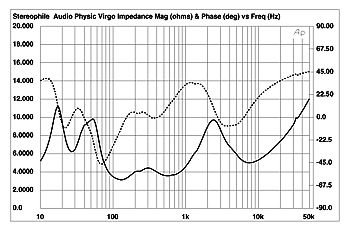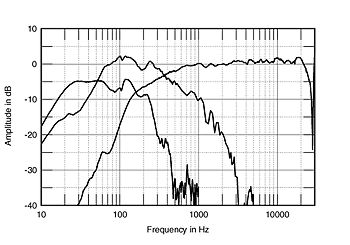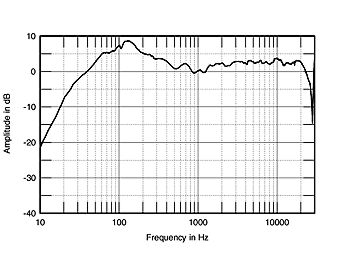| Columns Retired Columns & Blogs |
Audio Physic Virgo loudspeaker Measurements
Sidebar 4: Measurements
The Audio Physic Virgo is a reasonably hard load for an amplifier to drive, as shown by its plots of impedance magnitude and phase against frequency (fig.1). Not only does the impedance drop below 4 ohms for pretty much the entire midrange, but the phase angle is also moderately high in the upper bass and low treble. The changes in impedance with frequency, however, are small. The "saddle" in the magnitude trace at 27Hz indicates a low tuning frequency for the large port. The wrinkle at 230Hz is probably due to a cabinet resonance of some kind.

Fig.1 Audio Physic Virgo, electrical impedance (solid) and phase (dashed) (2 ohms/vertical div.).
Fig.2 reveals the side-mounted woofers crossing over to the front midrange unit around 370Hz, with a mild rolloff above that frequency. The port output covers quite a wide bandpass. Both port and woofer responses feature a mild blip at 230Hz, the frequency of the wrinkle in the impedance plot. The enclosure walls seemed relatively dead acoustically, with only mild modes noticeable at 120Hz and 300Hz on the side walls and at 660Hz on the front baffle, so it's probable that this peakiness between 200Hz and 300Hz is due to some kind of internal standing-wave phenomenon.

Fig.2 Audio Physic Virgo, acoustic crossover on tweeter axis at 50", corrected for microphone response, with nearfield midrange, woofer, and port responses plotted below 500Hz, 300Hz and 1kHz, respectively.
The response of the midrange unit and tweeter, shown to the right of fig.2, is astonishingly flat, with just a very slight rising trend noticeable. The sharp suckout just below 30kHz is an interference phenomenon due to the tweeter's "phase plate."
Averaged across a 30-degree horizontal window at the same distance, 50", on the tweeter axis, the speaker's response (fig.3) has a slight lack of energy in the upper midrange but again is very smooth and flat. There seems to be a broad hump in the lower midrange and upper bass in this curve, which was calculated by taking the complex sum—magnitude modified by phase—of the midrange unit, woofers, and port. While this correlates with MF finding the speaker to have a little extra midbass warmth—"maybe just too much of a good thing," he said—it does result in the Virgo having impressive low-frequency extension: this curve is down 6dB from the 1kHz reference level at 23Hz, despite the speaker fundamentally having an overdamped character.

Fig.3 Audio Physic Virgo, anechoic response on tweeter axis at 50", averaged across 30 degrees horizontal window and corrected for microphone response, with complex sum of nearfield midrange, woofer, and port responses plotted below 300Hz.
- Log in or register to post comments




































